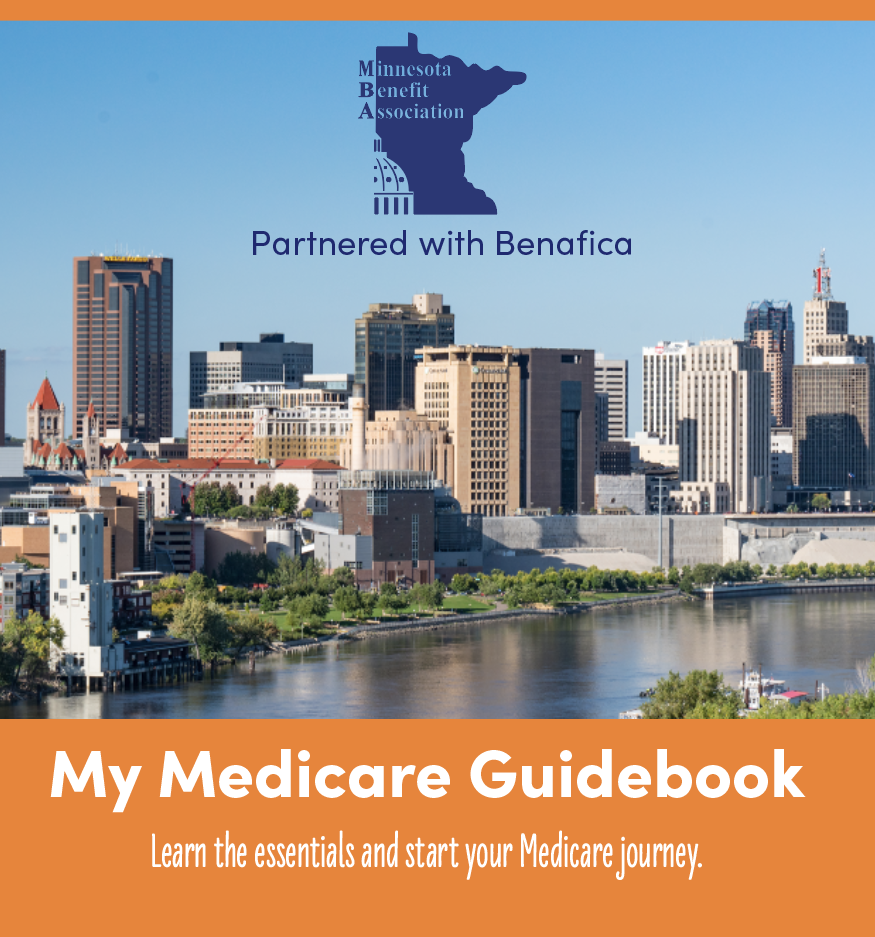Medicare
Looking for Medicare?
Minnesota Benefit Association, through our insurance administrators, has helped thousands of Minnesotans make the right Medicare choices. We offer unbiased advice, and have no special allegiance to one insurance company over another. The goal is to get each individual matched with the insurance company and the Medicare plan that is best suited for them.
Schedule a Consultation Call us at 651-358-2990 Email Us
MBA’s Guide to Medicare

Needs Analysis
Take a customized Needs Analysis with a licensed MBA Agent.
Topics include:
• Lifestyle Preferences
• Medical Needs
• Budget Analysis

Plan Selection
Get help finding the Medicare plan that is most suited to your specific needs.
MBA is a Minnesota nonprofit, not committed to any one insurance company and provides insurance plans from all available insurance carriers.

Year Round Customer Support
As your Medicare advocate, dedicated licensed Agents are available for you year round.
Customer support topics include:
• Moving to a new area
• Significant changes to your health
• Insurance company questions and concerns
Download our FREE Medicare Guide book.
- Everything you need to know about Medicare
- An indepth look at enrolling in Medicare
What is Medicare?
Medicare is a federal health insurance program that pays for a variety of health care expenses. It’s administered by the Centers for Medicare and Medicaid Services (CMS), a division of the Department of Health and Human Services (HHS). Medicare beneficiaries are typically senior citizens who are 65 years of age and older. Adults with certain approved medical conditions (such as Lou Gehrig’s Disease) or qualifying permanent disabilities may also be eligible for Medicare benefits.
Similar to Social Security, Medicare is an entitlement program. Most U.S. citizens earn the right to enroll in Medicare by working and paying their taxes for a minimum required period. However, even if you didn’t work long enough to be entitled to Medicare benefits, you may still be eligible to enroll, but you will pay more.
There are four different parts to the Medicare program. Parts A and B are sometimes called “Original Medicare.” The following is a Medicare overview describing the four parts.
Part A is Hospital Insurance
Medicare Part A does not cover the full amount of your hospital bill. You will share in the cost. You must pay a deductible before Medicare benefits begin. Medicare will then pay 100 percent of the cost up to 60 days in a hospital or up to 20 days in a skilled nursing facility. After that, you pay a daily coinsurance amount of at least $315. All Medicare benefits will end when you have used up your 90-day benefit period and any lifetime reserve days remaining in your account.
Part B is Medical Insurance
You share the costs for your medical care, typically 80/20. You’ll pay a small deductible each year before your Part B Medicare benefits begin. Then you generally pay 20% of the bill when you go to the doctor who accepts Medicare. Medicare pays 100% of the cost of lab services that help your doctor make a diagnosis.
Part C is Medicare Advantage
Medicare Advantage is optional, but to have this private insurance, you must also have Medicare Parts A and B (Original Medicare).
While all Medicare Advantage plans must provide all benefits of Original Medicare, plans can include different additional benefits depending on the private health insurer that offers it. Some plans might have a lower deductible and your share of the remaining costs might also be lower. Your Medicare Advantage plan may even cover certain health care services that Original Medicare does not cover like eye exams, hearing aids, dental care or health care received while traveling outside the United States.
Part D is Prescription Medication Insurance
If you have limited income and cannot afford your medications even with your Part D Medicare benefits, you may qualify for the Extra Help program for financial assistance with your monthly premium, deductible, copay or coinsurance.
The cost of prescription drugs is a significant reason why people choose a plan that helps cover the cost of prescription medication.
What is Medicare Supplement?
Need help paying your Medicare deductibles, copayments and coinsurance? A Medigap Supplement insurance policy helps pay for some of the cost that Original Medicare does not cover. There can be substantial ‘gaps’ in what Original Medicare (Medicare Parts A and B) pays for and many people choose to cover these gaps with a Medicare Supplement policy. Medicare Supplement plans do not cover your prescription drug costs.
You can get a Medicare Supplemental plan only if you have Original Medicare. Medigap plans only work with both Medicare Part A (hospital insurance) and Medicare Part B (medical insurance). If you have a Medicare Advantage plan, you do not need and cannot be sold a Medicare Supplement plan. Medigap plans do not cover your prescription drugs; for drug coverage you will need Medicare Part D or a Medicare Advantage with prescription drug coverage included.
Some people may have a Medicare Supplement or Part D coverage as part of their retirement plan.
If you are on Medicaid, have Veterans Administration benefits, or are on TRICARE, ask our Medicare specialists how this may affect your Medicare options.
You can get a Medicare Supplement plan through private insurance companies. The Medigap policy must be clearly identified as “Medicare Supplement insurance.” There are 10 different Medigap coverage options to choose from. Plans are labeled A, B, C, D, F, G, K, L, M and N to signify the plan differences. Plans E, H, I and J are no longer available. Additionally, Minnesota offers unique hybrid plans called Cost Plans, which have been very popular over the last 10 years with Minnesota seniors (scroll down for more information on Cost Plans).
Because Medigap policies are regulated by State and Federal laws, benefits for all options are the same regardless of insurer. The differences will be in the price, who administers the plan, and which of the ten options the insurer chooses to offer. You may want to choose a health insurer that you already feel comfortable with, or you can shop around for the best prices.
You also have the option to buy a Medicare SELECT policy because you are a Minnesota resident. Medicare SELECT is a type of Medigap policy sold in some states that requires you to use hospitals and, in some cases, doctors within its network to be eligible for full insurance benefits (except in an emergency).
Open Enrollment
Open enrollment for Medicare is from October 15 – December 7 for January 1st coverage. During the annual open enrollment period, you can:
- Change from Original Medicare to a Medicare Advantage plan
- Change from a Medicare Advantage plan back to Original Medicare
- Switch from one Medicare Advantage plan to another Medicare Advantage plan
- Switch from a Medicare Advantage plan that doesn’t offer drug coverage to a Medicare Advantage plan that offers drug coverage
- Switch from a Medicare Advantage plan that offers drug coverage to a Medicare Advantage plan that doesn’t offer drug coverage
- Join a Medicare Prescription Drug plan
- Switch from one Medicare drug plan to another Medicare drug plan
- Drop your Medicare prescription drug coverage completely
Your open enrollment for Medigap supplemental insurance begins the first month you are covered under Medicare Part B. You have six months in which to enroll in a Medicare Supplement plan regardless of your health. If you are under 65, check with Minnesota’s Social Security Administration to see if they offer additional open enrollment periods.
As long as you enroll during the initial six-month open enrollment period, Medicare Supplements are guaranteed issue; the insurance company cannot refuse to sell you a Medigap policy or charge you more because you have health problems. You may, however, have to wait up to six months for coverage on any pre-existing conditions.
That means if you have a specific health problem when you enroll, you may have to wait up to six months to be covered for medical services associated with that health problem. Original Medicare will still cover that health problem even if your Medicare supplement plan doesn’t cover your out-of-pocket costs.
If you do not enroll in a Medicare supplemental plan during your open enrollment period, then the private insurance company may “underwrite” the plan. That means you may be subject to a physical, and the insurance company can either refuse to sell you the plan or they can adjust your premium based on your health status.
We encourage you to enroll in all your Medicare options as soon as possible to take full advantage of the coverage open to you. You should aim to avoid any increase in premium or late enrollment penalties by fully understanding your enrollment periods and responsibilities under Medicare.
If you enroll in a Medicare Advantage plan, you must cancel your Medigap policy; you cannot have both policies at the same time (as this would amount to dual coverage). However, if you later return to Original Medicare (Parts A and B), you have a twelve-month special enrollment period to sign up for a Medigap supplemental plan.
Special Enroll Program (SEP)
Under special circumstances outside of Medicare Annual Enrollment Peroid (AEP) you may be eligible for a Special Enrollment Period (SEP), to enroll into a new plan.
How insurance companies set Medigap premiums
There are three ways an insurance company can set Medigap premium rates:
Community Rated Premiums
“Community-rated” (or “no-age-rated”) premiums are the same for everyone, regardless of age.
Issue-Age-Rated Premiums
“Issue-age-rated” (or “entry-age-rated”) premiums are based on your age when you first buy the policy. The sooner you enroll, the less you will pay.
Attained-Age-Rated Premiums
“Attained-age-rated” premiums are based on your current age, meaning it goes up as you grow older.
Other factors impacting the premium rates can include inflation, geography and medical underwriting (if you did not enroll when first eligible) and other discounts. You should check with each specific health insurer to see how it sets Medigap prices before you buy.
Download our FREE Guide to
Medicare Brochure for a quick overview.
- What is Medicare?
- When and how do I enroll in Medicare?
- What are my Medicare Options?
Download
Watch MBA’s Enroll in Medicare 10 minute video.
It’s everything you’ll want to know.
Schedule a Consultation Call us at 651-358-2990 Email Us
Benafica is the insurance administrator for the Minnesota Benefit Association and is licensed to sell Medicare.
The information is for educational purposes only. Medicare has neither reviewed nor endorsed this information.



